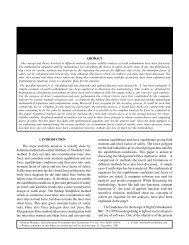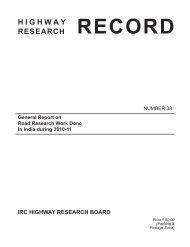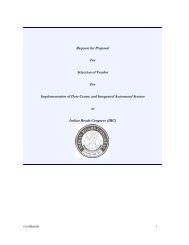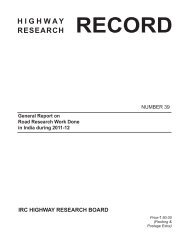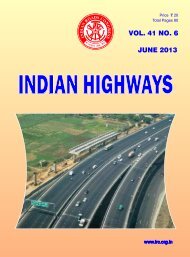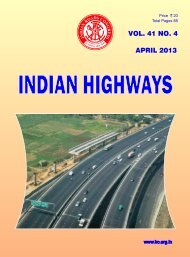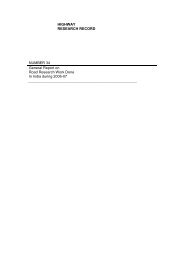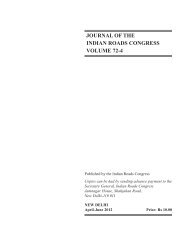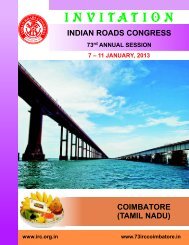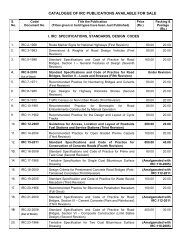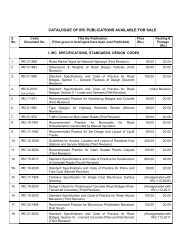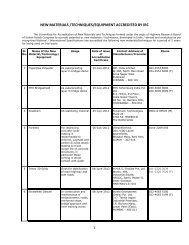A Review of Highway Agencies in the South Asia Region
A Review of Highway Agencies in the South Asia Region
A Review of Highway Agencies in the South Asia Region
Create successful ePaper yourself
Turn your PDF publications into a flip-book with our unique Google optimized e-Paper software.
A <strong>Review</strong> <strong>of</strong> <strong>Highway</strong> <strong>Agencies</strong> <strong>in</strong> <strong>the</strong> <strong>South</strong> <strong>Asia</strong> <strong>Region</strong><br />
C.2.5 F<strong>in</strong>anc<strong>in</strong>g Road Infrastructure<br />
In 2009, <strong>the</strong> tra<strong>in</strong><strong>in</strong>g expenditures were approximately US$1.1 million 41 for technical and<br />
nontechnical skills development.<br />
Internal assessment and on-<strong>the</strong>-job tra<strong>in</strong><strong>in</strong>g opportunities play a key role <strong>in</strong> assist<strong>in</strong>g<br />
staff to ga<strong>in</strong> contact center, bus<strong>in</strong>ess adm<strong>in</strong>istration and o<strong>the</strong>r qualifications. NZTA<br />
has a Pr<strong>of</strong>essional Development Partner Program <strong>in</strong> partnership with <strong>the</strong> Institution <strong>of</strong><br />
Pr<strong>of</strong>essional Eng<strong>in</strong>eers New Zealand to <strong>of</strong>fer a Graduate Development Program.<br />
NTZA has a strong focus on develop<strong>in</strong>g leadership with<strong>in</strong> <strong>the</strong> organization. It has adopted<br />
a new leadership competency framework for all leadership roles. The expectations from its<br />
leaders are clearly articulated <strong>in</strong> <strong>the</strong> position descriptions for each role and are measured<br />
specifically through <strong>the</strong> performance management system that <strong>the</strong> organization has<br />
adopted for all positions.<br />
Research and Knowledge Development<br />
NTZA is responsible for <strong>the</strong> adm<strong>in</strong>istration <strong>of</strong> a contestable land transport research fund. It<br />
is <strong>in</strong>tended that NZTA’s research program will set out a roll<strong>in</strong>g three-year plan <strong>of</strong> research<br />
activity to align itself with <strong>the</strong> new three-year NLTP fund<strong>in</strong>g cycle.<br />
The research program 42 consists mostly <strong>of</strong> <strong>in</strong>dustry-generated research, with a small<br />
amount <strong>of</strong> directed research. Industry-generated research comprises research projects<br />
developed by researchers <strong>in</strong> conjunction with end users, and fund<strong>in</strong>g is awarded on a<br />
contestable basis via a two-stage application process.<br />
Directed research comprises research projects that NZTA has commissioned and requested<br />
researchers to submit a proposal on. This ‘top-down’ approach is designed to fill <strong>the</strong> gaps<br />
not covered by <strong>in</strong>dustry-generated research.<br />
The NZTA uses a Research Reference Group to advise it on research proposals. The Group is<br />
chaired by NZTA and comprises representatives <strong>of</strong> key stakeholder groups with appropriate<br />
expertise.<br />
The stakeholder groups <strong>in</strong>clude representatives from various government levels, polic<strong>in</strong>g,<br />
consultants, contractors, universities and research <strong>in</strong>stitutes, road users, and o<strong>the</strong>r public<br />
<strong>in</strong>terest groups.<br />
F<strong>in</strong>anc<strong>in</strong>g<br />
The National Land Transport Fund is a primary source <strong>of</strong> fund<strong>in</strong>g for New Zealand’s land<br />
transport system, and funds all types <strong>of</strong> roads, road polic<strong>in</strong>g program, public transport<br />
and o<strong>the</strong>r activities such as research and sector tra<strong>in</strong><strong>in</strong>g. Figure C12 describes <strong>the</strong> overall<br />
fund<strong>in</strong>g allocation.<br />
A fuel excise duty, charges on diesel and heavy vehicles (road user charges), and vehicle<br />
licens<strong>in</strong>g and registration fees are <strong>the</strong> ma<strong>in</strong> sources <strong>of</strong> funds. Fuel excise and road user<br />
charges revenue are fully dedicated to <strong>the</strong> National Land Transport Fund for allocation to<br />
land transport activities. In addition, more fund<strong>in</strong>g comes directly from <strong>the</strong> government and<br />
local authorities as well as developers’ contributions <strong>in</strong> some cases.<br />
New Zealand has toll bridges only s<strong>in</strong>ce 2009 when NGTR opened on State <strong>Highway</strong> 1, north<br />
<strong>of</strong> Auckland. To br<strong>in</strong>g forward construction, NZTA borrowed aga<strong>in</strong>st future revenue to be<br />
generated through toll collection.<br />
41 NZTA (2009). Annual report. Page: 69.<br />
42 NZTA (2008), NZ Transport Agency’s Approach to Research 2009–12, GPS activity class: sector research, October 2008.<br />
133



